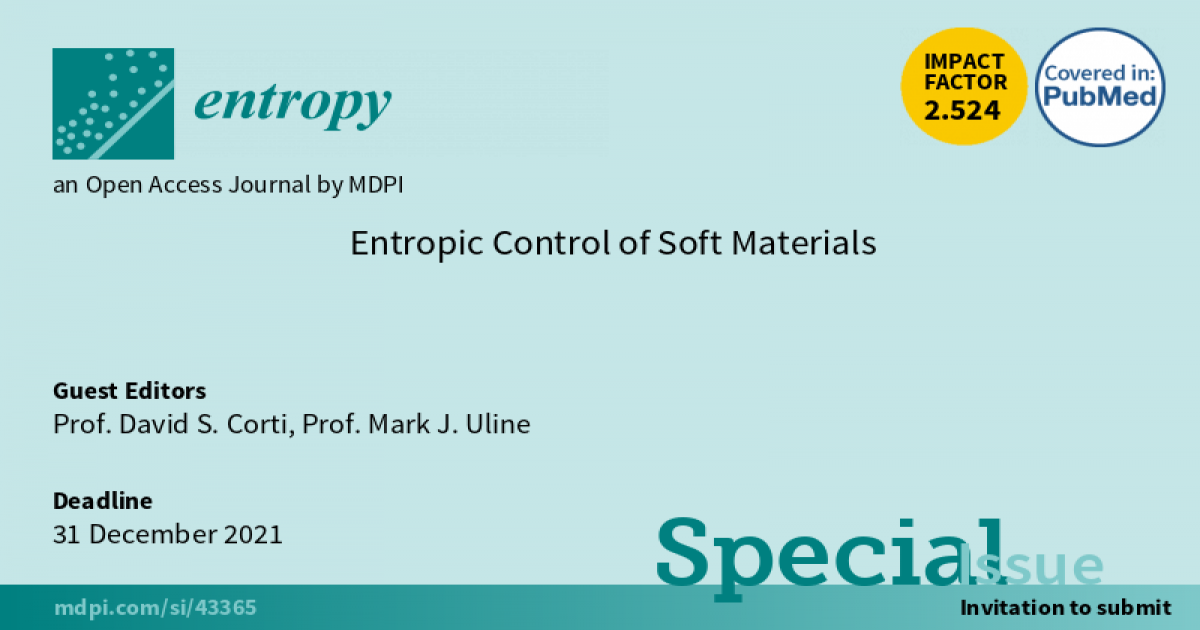Entropic Control of Soft Materials
A special issue of Entropy (ISSN 1099-4300).
Deadline for manuscript submissions: closed (31 December 2021) | Viewed by 7514

Special Issue Editors
Interests: molecular thermodynamics; thermodynamics; colloidal dispersions; complex fluids; atomic force microscopy
Interests: statistical mechanics; thermodynamics; cell membrane biophysics; nucleation; biomechanics
Special Issue Information
Dear Colleagues,
In statistical thermodynamics, entropy is determined either by the logarithm of the number of accessible states for an isolated system (i.e., Boltzmann’s entropy formula) or the average of the logarithm of the probability of the various microstates for a non-isolated system (i.e., Gibbs’ entropy formula). Entropy is, therefore, a “global” property, in that its value does not apply to an individual microstate but rather to a collection of microstates. In contrast, a “local” property can be assigned to a given microstate, an example of which is the energy. Although local properties directly affect the behavior of a system (i.e., the actual forces or energies of interactions between particles), changes in entropy do nonetheless appear to yield driving forces that serve to guide processes in preferred directions. Again, such “entropic forces” are not true forces, but arise because of sufficient differences in the probabilities between collections of microstates (described via some appropriate order parameter). These driving forces may also be described as gradients of a potential of mean force, or a difference in free energy, which is a further acknowledgment that these “forces” are only effective and result from a suitable averaging of the actual forces over various subsets of all the microstates.
Free energy differences, however, have both energetic and entropic contributions. Hence, “entropic forces” or “entropic control” are typically applied to systems in which free energy differences or changes in the potential of mean force are either exclusively based on changes in entropy (where for example there are no interparticle forces) or for which the entropic contributions are comparable to or dominate the energetic contributions to the microstate probabilities. Therefore, from this perspective, we introduce this Special Issue on the entropic control of soft materials, which offers a collection of papers that touch upon the broad range of systems of scientific and technological interest that exploit entropic differences to drive or control their behaviors. For example, there are the purely athermal systems (i.e., hard particles) in which entropy is the sole contributor to the free energy, and hence is the only driver or determinant of the resulting phase behavior. Colloidal systems provide other examples of the use of entropic control, either through the introduction of small colloids into a suspension of large colloids or the utilization of passive structures, both of which give rise to entropic effects that can drive aggregation and/or deposition. In addition, there are many examples of entropically driven effects in biological systems, either through changes in polymer/protein configurations, lock-and-key mechanisms, or deposition/phase behavior driven by changes in orientations (e.g., Onsager theory of isotropic/nematic transitions), to name just a few.
This Special Issue is by no means an exhaustive overview of the rather diverse and rich area of entropic control, but includes contributions from authors across various fields of research that have traditionally exploited and/or utilized entropic control as a means to better understand and/or guide the generation of structures/systems with specific properties of interest.
Prof. David S. Corti
Prof. Mark J. Uline
Guest Editors
Manuscript Submission Information
Manuscripts should be submitted online at www.mdpi.com by registering and logging in to this website. Once you are registered, click here to go to the submission form. Manuscripts can be submitted until the deadline. All submissions that pass pre-check are peer-reviewed. Accepted papers will be published continuously in the journal (as soon as accepted) and will be listed together on the special issue website. Research articles, review articles as well as short communications are invited. For planned papers, a title and short abstract (about 250 words) can be sent to the Editorial Office for assessment.
Submitted manuscripts should not have been published previously, nor be under consideration for publication elsewhere (except conference proceedings papers). All manuscripts are thoroughly refereed through a single-blind peer-review process. A guide for authors and other relevant information for submission of manuscripts is available on the Instructions for Authors page. Entropy is an international peer-reviewed open access monthly journal published by MDPI.
Please visit the Instructions for Authors page before submitting a manuscript. The Article Processing Charge (APC) for publication in this open access journal is 2600 CHF (Swiss Francs). Submitted papers should be well formatted and use good English. Authors may use MDPI's English editing service prior to publication or during author revisions.
Keywords
- entropic control
- colloidal dispersions
- athermal systems
- entropy in biological systems
- polymers
- liquid crystals
- potentials of mean force
Benefits of Publishing in a Special Issue
- Ease of navigation: Grouping papers by topic helps scholars navigate broad scope journals more efficiently.
- Greater discoverability: Special Issues support the reach and impact of scientific research. Articles in Special Issues are more discoverable and cited more frequently.
- Expansion of research network: Special Issues facilitate connections among authors, fostering scientific collaborations.
- External promotion: Articles in Special Issues are often promoted through the journal's social media, increasing their visibility.
- Reprint: MDPI Books provides the opportunity to republish successful Special Issues in book format, both online and in print.
Further information on MDPI's Special Issue policies can be found here.







